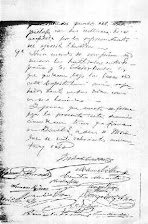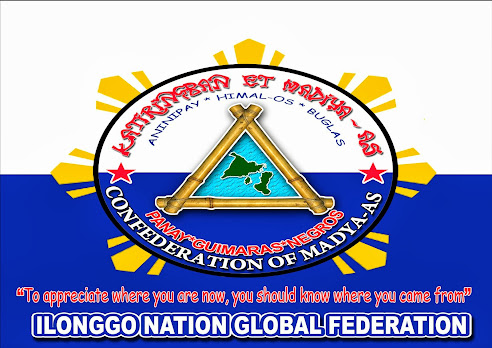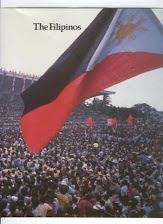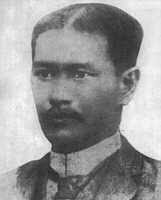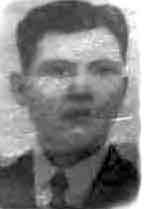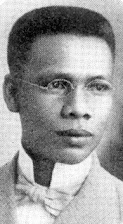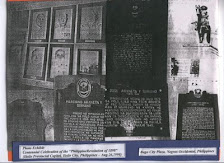A CHRONOLOGY: THE ILONGGO NATION
(By DinggolAranetaDivinagracia-IlonggoNationMovement)
CHRONOLOGICAL EVENTS THAT SHAPED THE DESTINY OF THE "ILONGGO NATION"
PROLOGUE: “It is rather speculative as it is without basis of history if we mean of "history" is that which had been written for us by the “tutas” or lackeys of our colonial and imperial masters." --Benjie Evicner Estuche (INM Co-Founder)
I - THE BIRTH OF THE ILONGGO NATION
Sometime in the past:
The Maragtas “legend” explained and the ancient Chinese Ming Dynasty chronicle confirmed, that sometime in the 13th century ten (10) Malay Datus together with their families, households, and subordinates fled the tyrannical rule of Makatunaw, the Shri-Vijaya Sultan of Bornay (Borneo).
Led by the Sultanate Minister Datu Putih, they sailed their “balanghais” unto uncertain fate and landed in the island of "Aninipay" (Panay). They bartered their gold and jewelry with the local Ati Chieftain Marikudo for the lowlands, plains, and valleys of the island they called "Madya-as" or Paradise. The land where time began the birth of the Ilonggo Nation and the cradle of an ancient Filipino civilization.
For about 300 years before the coming of the Spaniards, the people lived in comparative prosperity, contentment, and peace under an organized form of government, the "Katiringban et Madia-as" or the Confederation of Madya-as and with such laws as the Code of Sumakwel the Code of Kalantiaw.
II - THE SPANISH CONQUEST:
-1521: March 16 -Portuguese Ferdinand Magellan sailing for Spain to explore the Far East for spices, anchored his ships in Humumu (Homonhon) Eastern Samar. He went ashore and claimed the islands for the Spanish King Philip II after staking by the shore the royal flag and a cross then named it "Las Felipinas". On the 31th in Masua (Limasawa) Southern Leyte the first mass was celebrated by Father Pedro de Valderrama.
On April 27th Magellan was slain in the battle of Mactan in Sugbu (Cebu) by native warriors under Chieftain "Cilapulapu" (Lapulapu).
-1566: The Spaniards under Miguel Lopez de Legaspi reached Panay island from Cebu, first landing in Pan-ay, Capiz for provisions and thereafter proceeded and established a settlement in Araut (Dumangas) and Ogtong (Oton) both in Iloilo. The Conquistadores, subjugated our forebears not only with superior weapons and the sword; but likewise, with the Bible and the Cross.
-1581: The encomienda, the seat of Spanish power was moved from Ogtong (Oton) to La Villa Rica de Arevalo.
-1616: Due to recurrent raids by Moro pirates and foreign privateers, the Spaniards moved close to the mouth of Irong-irong river and built the fortress "Santo Rosario" now known as Fort San Pedro.
-1688: The Spaniards shortened Irong-Irong or Ilong-Ilong to "ILOILO", which became the capital of the province.
-1855: The rapid economic growth of the place, led to the opening of the port of Iloilo to world trade. Thanks to British Nicholas Loney, Iloilo soon emerged to be the biggest center of commerce and trade in Visayas and Mindanao, second only to Manila.
Unfortunately, however, our local weaving industry was adversely affected as textile imports flooded the market.
-1896: The Ayuntamiento on Iloilo (City Government) which was established in 1890 under the Becerra Law was given the honor by virtue of the Royal Decree of having a Coat-of-Arms with the inscription "La Muy Leal y Noble Ciudad de Iloilo".
This is considered a sham and an act of ignominy by many Ilonggos of today. Like the title "Queen City of the South" which is being disputed as bestowed upon us for being the Queen Regent's minions, "Tuta" or pet City.
III - THE REVOLUTION AGAINST SPAIN:
Meanwhile, almost four centuries of Spanish subjugation; of apathy, cruelty, and injustice; greed and misconduct of the elite; the immoral and abusive theocracy (fuera los buenos) alienated the populace.
These created a social volcano of an angry enslaved society in despair and discontentment, most especially among the hoi poloi, the lowly masses.
-1586: When Hamtic (Antique) was still part of Ogtong, the "Igbaong Revolt" started when the local leaders protested against the cruelty and abuses of the encomienderos and friars due to conscription or forced labor, either to work in their haciendas or construction of churches.
-1663: "Tapar", a babaylan and nativist of Oton, Iloilo waged the "Tapar Revolt". Poorly armed these early movements were easily quelled. But the Ilonggo patriots did not give up; they continued their struggle for freedom.
-1889: February 15 - In Barcelona, Spain the first issue of "La Solidaridad" a political propaganda publication founded by Graciano Lopez Jaena of Jaro, Iloilo City was published. With Dr. Jose Rizal, Marcelo H. del Pilar, and others --they advocated reforms for the welfare of the Filipino people.
The "La Solidaridad", El Filibusterismo, and Noli mi Tangere; notwithstanding, difficulties since circulation was strictly banned in the "Islas"; and the martyrdom of native Priests Gomez, Burgos, and Zamora (GOMBURZA) was the spark that ignited the event that radically changed Filipino history.
-1892: July 7-The Katipunan "KKK" was founded by the "Great Plebeian" Andres Bonifacio and fellow workers in Tondo, Manila that planned and initiated the armed Revolution.
-1896: August 26 -Was the "Cry of Balintawak" where KKK Supremo Andres Bonifacio declared the "Katagalogan Republic".
-1896: December 30 - Dr. Jose Rizal of Calamba, Laguna; an illustrado-reformist of many talents, who was not in favor of the planned armed Revolution was executed by the Spaniards instigated by the clergy at Bagumbayan now Luneta. This event emboldened the "Indios", including the elite and many other illustrados to join in the revolution.
-1897: March 17 - After the “Cry of Balintawak,” Katipunan Supremo Andres Bonifacio immediately commissioned his friends Francisco del Castillo and Candido Iban to start the uprising in their home province of Aklan (still part of Capiz). Gen. del Castillo, who led 82 Aklanon recruits was killed in battle on March 17, 1897. His men were enticed to surrender with promise of amnesty; but those who gave up were deceived, imprisoned, tortured and 19 were executed in public.
Thus, the Katipunan led revolution in Aklan, Capiz ended in defeat.
-1897: May 10 - Andres Bonifacio and his brother Procopio were executed in Cavite after a bogus trial for treason. A black chapter in the history of the Revolution according to many, as the victims were sacrificed in the altar of ambition and self-serving interest of the illustrado class as personified by Emilio Aguinaldo.
IV - THE "COMITE DE CONSPIRADORES" OF MOLO
-1898: March 18 - The "Comite de Conspiradores" was formed in Parian now Molo in Iloilo City initiated by Don Francisco Felipe Villanueva and headed by Don Raymundo Angulo Melliza. The members were "Parianons" that included; Pablo Soriano Araneta, Fernando Salas, Francisco Soriano, Jovito Servando Yusay and from Jaro; Roque Haplasca Lopez, Nicolas Jalandoni, and Simon Lopez Ledesma.
This became the nucleus that started the highly disciplined, well-financed, and well-organized covert revolutionary movement in the Island of Panay.
Five months later, together with the revolutionary leaders outside the City of Iloilo led by Capitan Martin Teofilo Delgado y Bermejo of Santa Barbara, Iloilo they formed a revolutionary government and thus, the "Estado Federal de Bisayas" was conceived. Thereat, Don Raymundo Melliza and Dr. Pablo Araneta chose Capitan Martin T. Delgado as "General en Jefe de los Tropas del Ejercito Libertador de Visayas y Governador Politico-Militar” based in Sta. Barbara, Iloilo.
Thereafter, Gen. Roque Lopez, the elected President of the Assembly and Gen. Pablo Araneta, the designated Panay Island Commanding General and Chief Expeditionary Forces for the Visayas and other leaders of the covert Movement secretly maintained liaison with their relatives and friends in Negros and nearby islands to start the armed uprising in their areas. More notably, the brothers Col. Emilio and Col. Eduardo Esteban as commissioned by the Chief of Staff, Gen. Pablo Araneta of the Visayas Expeditionary Forces.
Dr. Vicente Armada Locsin, of Janiuay, Iloilo acted as Confidential Intelligence Emissary Officer of the Central Revolutionary Committee based in Molo, Iloilo and coordinated with the Panay and Negros revolutionary councils. He later married Doña Trinidad Teves, and settled permanently in Dumaguete City, Negros Oriental.
Earlier,
Capitan Martin Delgado together with Pedro Monteclaro, Adriano
Hernandez, Quintin Salas and others led the volunteer battalion of
Ilonggo contingents under the Spaniards who fought against Gen.
Aguinaldos forces in Cavite and Pampanga. These military expeditions
were mostly financed by Iloilo’s elite, more notably; Gobernadorcillo Don Eugenio Jalandoni Lopez (married to Marcela Villanueva) of
Salog (Jaro) and Don Felix de la Rama (married to Concepcion Araneta) of
Parian (Molo).
Later,
however, Capitan Martin, with others, conspired for the Visayans
instead of supporting the Spanish cause and organized an armed and open
rebellion against the Spanish authorities in Panay.
V - THE CEBU REVOLUTION:
Gen. Pantaleon “Leon Kilat” Villegas, of Bacong, Negros Oriental as directed by the Negros Island revolutionary leaders organized the Revolucionarios in Cebu and on the 3rd of April, 1898 led the armed uprising against the Spanish authorities together with Luis Flores, Florencio Gonzales, Candido Padilla, Andres Abellana, and others.
Less than a week later, on the 8th of April a Good Friday of "Semana Santa" or Holy Week, Leon Kilat was brutally assassinated led by his very own trusted Aide-de-Camp Apolinario Alcuitas in the town of "Kabkad" now Carcar, Cebu. The brains behind his slaying remain a mystery until today.
When Spain formally surrendered to the Estado Federal de Bisayas in Iloilo, Cebu Politico-Military Governor Gen. Adolfo Montero, created a Cebuano caretaker committee headed by Pablo Mejia before he left for Zamboanga together with his Negros island counterpart Colonel Isidro de Castro y Cinceros, and the last duly constituted Spanish authority in the Philippine, Governor-General Don Diego de los Rios y Nicolau.
Shortly, thereafter, Pablo Mejia turned over the gavel to Luis Flores, a pro-Aguinaldo man in Cebu. Mejia was assassinated and Flores resigned. Julio Llorente succeeded to head the Council in Cebu but left for Manila with the threat of assassination. Then Don Segundo Singson assumed the Presidency of the Cebu provincial council.
VI - GEN. AGUINALDO DECLARES INDEPENDENCE
-1898: May 24 - Visayans leaders recognized Emilio Aguinaldo's revolutionary government, since it was for a federal Philippines, with a Federal State each for Luzon, Visayas, and Mindanao. On this date, however, upon the advice of Ambrosio Rianzares Bautista, an autocratic regime was established with Emilio Aguinaldo as dictator.
This move was opposed by Apolinario Mabini of Batangas, considered as the “Brain of the Revolution” and he was supported by all the Visayan leaders.
-1898: June 12 - Under this dictatorship, Gen. Emilio Famy Aguinaldo declared in Kawit, Cavite the Independence of Filipinos and birth of the Philippine Republic; its flag unfurled for the first time while Marcha Nacional Filipinas was played which became the Philippine National Anthem. This proclamation of independence was not recognized by Spain, the United States nor by any other foreign nation.
Hence, it has a "de facto" government --as at least one, just one other sovereign nation must recognize it's independence to qualify as "de Jure" meaning legitimate or legal.
VII - ILONGGO NATION'S INDEPENDENCE!
-1898: November 5 - Southern Negros Command under Gen. Juan "Tan Juan" Anacleto Torres Araneta declared at the Bago Plaza in Negros Occidental the "Independent Negros Republic". Tan Juan's Aide-de-Camp was his eldest son Col. Jaime Sarmiento Araneta. Earlier, the Northern Negros Command under Gen. Aniceto Ledesma Lacson over-powered the Spanish forces in the northern towns of Manapla, Cadiz, Talisay, and Silay led by Gen. Leandro de la Rama Locsin. Negros Governor Rosendo Ledesma Lacson served as close Adviser and "Confidante" to his brother Gen. Aniceto Ledesma Lacson.
In the south, Gen. Marciano Soriano Araneta led the revolutionaries who valiantly fought and captured the Spanish "Cuartel General" in Mangkas now La Carlota City; while Don Diego de la Viña of Hacienda Vallehermoso in the Town of Guihulngan, and his men overthrew the Spanish authorities in Dumaguete City, Negros Oriental.
-1898: November 6- Don Diego de Los Rios y Niculao, the last duly constituted Governor-General of Spain in the Philippines represented by Colonel Isidro de Castro (the Negros Island Politico-Military Governor) formally surrendered to the Independent Republic of Negros revolutionary leaders led by Gen. Aniceto Ledesma Lacson - Presidente and Gen. Juan “Tan Juan” Araneta-Secretary of War in Bacolod City, Negros Island as evidenced by the "Acta de Capitulacion-1898”.
-1898: November 17 - The Provisional Revolutionary Government of the Visayas and Mindanao was proclaimed by General-en-Jefe Martin Delgado during the “Cry of Sta. Barbara” in Iloilo. This was replaced on November 23, 1898, by a politico-military government restricted only to the provinces in the Visayas.
The leaders preferred instead an arrangement of a National Federation composed of the separate States each for Luzon, Visayas and Mindanao because of the many separate islands of the archipelago in Visayas and Mindanao and since they did not want to recognize the supremacy of Aguinaldo and the Tagalogs over their own government.
-1898: Nov. 26 - In a meeting of the Negros island cantonal government, General Juan "Tan Juan" Araneta y Torres sponsored a resolution which was unanimously approved to set up the Federal Republic. "I proposed, that this island, after having attained its liberty and independence by means of a brilliant feat of arms, thus winning an honorable place in the concert of civilized nations, be governed by prestigious men in our country who knows its needs and understand its glorious ideals. For this reason, I believe that the best government to realize the beautiful aspiration of our island, which is also that of the entire Filipino people, is that of a Federal Republic." The approved resolution was duly documented by Don Melecio Severino, Secretary-General.
-1898: December 2 - After series of long and serious discussions and legitimate deliberations on nation-building, it was decided to consolidate the cantonal governments in both Central and Western Visayas into the Panay government based in Iloilo and thus, was established the “Estado Federal de Bisayas” or Republika Federal sang Kabisay-an (Federal Republic of the Visayas).
By the middle of December, the revolutionaries led by Gen. Esteban Contreras and his adjutants, Col. Pascual Barza and Col. Juan Arce and aided by Captain Alejandro Balgos, the Capizeños defeated and drove the Spanish forces out of the Capiz Province, a few days before Spanish authorities totally capitulated to the authority of the "Gobierno de Canton de Visayas" or Federal Government of the Visayas in Iloilo City. In Romblon island, Col. Diego de Diaz commanded the revolutionary forces based in this part of Capiz.
During the revolution, the Province of Bohol was part of the Visayan Republic with headquarters at Santa Barbara, Iloilo.
The Revolutionary Forces led by Gen. Martin T. Delgado (General-en-Jefe), Gen. Pablo Soriano Araneta, Gen. Leandro Locsin Fullon of Antique and Gen. Esteban Contreras of Capiz, after several fierce battles had already taken all the towns in Panay. While the revolutionaries under Gen. Roque Lopez of Jaro, Gen. Quintin Salas of Dumangas, Gen. Teresa Magbanua of Pototan, Gen. Adriano Hernandez of Dingle, Gen. Angel Corteza of Molo and others had already encircled the whole City of Iloilo.
-1898: December 23 - Governor-General Don Diego de Los Rios, in order to avoid further bloodshed, relinquished Spain’s banner and official saber --the symbol of Spanish authority for formal surrender to leaders of the approaching victorious revolutionary forces, thru Iloilo "Alcalde-Mayor" Jose Ma. Gay y Soriano. The symbolic formal surrender was negotiated by a committee composed of members of the Revolutionary Council; namely: Jovito Servando Yusay, Ramon Avanceña, Francisco Felipe Villanueva and with Francisco Soriano and Gen. Pablo Soriano Araneta as requested by the Alcalde-Mayor being his first cousins. Also present was Don Juan Benedicto de Leon who took over as the Alcalde-Mayor of Iloilo City.
-1898: December 24 - Gov. General Don Diego de Los Rios, evacuated for Zamboanga on his way home to Spain together with Spanish Politico-Military Governor of Negros, Col. Isidro de Castro, and Cebu Politico-Military Governor Gen. Adolfo Montero, who hastily created an all Cebuano caretaker committee before he left.
-1898: December 25 - Following the departure of the Spaniards, Gen. Martin T. Delgado together with Gen. Adriano Hernandez, and other leaders made a triumphal entry into the City of Iloilo followed by a victorious parade of revolutionaries to Plaza Alfonso XII, which was immediately renamed “Plaza Libertad.” and there, after the unfurling of a "Tri-Starred" Philippine Flag, he declared the Independence of the Federal Republic of the Visayas amidst loud shouts of "Viva Revolution! Fuera España! Viva Libertad!" by the huge crowd.
The Visayan revolution spearheaded by the Ilonggos established the “First Republic” in the whole of Asia.
VIII - THE AMERICAN INVASION OF THE ILONGGO NATION
-1898: December 27 -Two days later, on this date without formal Declaration of War, American Military Forces led by Gen. Marcus P. Miller arrived in four US warships to Iloilo harbor and demanded the surrender of the City of Iloilo.
Several negotiations were made but leaders of the newly established infant sovereign Visayan Nation based in Iloilo vehemently refused to surrender their battle-scarred freedom, independence, and legitimate government. It should be noted, that the “Spanish-American War” was between these two belligerent forces and should not involve in any way, the sovereign Visayan Republic by virtue of Spain’s formal surrender earlier.
On the other hand, Gen. Aguinaldo’s forces were still considered "subjects" under the Spanish crown, as Spain never formally surrendered to his self-proclaimed Philippine Republic in Kawit, Cavite nor to the Malolos Republic in Bulacan, the Constitution of which was drafted by Ilonggo Don Gregorio Soriano Araneta - Secretary General.
Simply put, they won several sporadic battles but not the over-all war in the island of Luzon against Spain.
-1899: February 2 -An American naval force appeared along the coastline of Negros ready for war. Gen. Aniceto Lacson, Negros President, seeing no chance of winning against the new invaders opted not to fight and safely ceded control after guarantees of property rights were made.
Moreover, the elite Negros leaders were more interested in peace with America for commercial consideration as a fertile market for their booming sugar industry.
-1899: February 7 -Without expecting surrender and peaceful take-over, the Americans began the continuous naval bombardment of Iloilo City for about a week that brought irreparable damage and totally demolished the historic “Fort San Pedro“ citadel.
-1899: February 14 -American troops led by Gen. Robert Hughes landed at Fort San Pedro, near Calle Santo Rosario and forced their way into the City. Villages were razed to the ground and hundreds of civilians were brutally killed, including defenseless women and small children, referred to by the ferocious invaders as uncivilized Chinese half-breeds.
-1899: February 22 -A sad chapter in our history as Iloilo City fell to the American invaders. But still, Ilonggo troops fought the Americans in pitched battles in towns around the City. The resistance continued even after the surrender of the Visayan Supremo Gen. Martin Teofilo Delgado y Bermejo.
IX - THE FALL OF THE FEDERAL REPUBLIC OF THE VISAYAS
-1899: April 27 - Gen. Aguinaldo issued a decree abolishing the Federal Republic of the Visayas, which the Visayan leaders openly ignored since they were not under his authority and jurisdiction. The embattled Republic continued to function, moving its capital from Sta. Barbara to Cabatuan in Iloilo.
-1899: May 1 - US Secretary of State John Hays handed to French Ambassador Jules Cambon the amount due to Spain under the Treaty of Peace (Paris) at the U. S. State Department to formally end the eight months Spanish-American war.
-1899: Sept. 23 -The civilian government of the "Estado Federal de Bisayas" or the Federal Republic of the Visayas, finally ceased to exist on September 23, 1899, when the last President Don Jovito Servando Yusay signed it's dissolution. This was brought about by a military "coup-de-etat" in the town of Cabatuan, Iloilo by its own military arm led by the General-en-Jefe Martin Teofilo Delgado, as instigated by General Ananias Diokno of Aguinaldo's government in Luzon.
Thereafter, the free, independent, and sovereign Visayan nation spearheaded by illustrious Ilonggos was replaced by Gen. Martin Delgado and his Politico-Military Government, subservient to Gen. Emilio Aguinaldo’s so-called Philippine Republic based in Luzon that had won several battles, but never the total war against Spain nor the U.S.A.
About a month later on October 28, 1899, General Delgado was designated by Gen. Aguinaldo as head of the Superior Council on the island of Panay.
Earlier, Gen. Pablo Soriano Araneta, the Panay Island commanding general and Chief of the expeditionary forces for the Visayas was among the officials ordered arrested and detained for not favoring the military "coup-de-etat" to take over the civilian government of the Estado Federal de Bisayas.
Moreover, he was suspected as the brain behind the ambush in Igbaras, Iloilo of the "coup-plotters" military contingent by forces loyal to the civilian government of the Estado (State).
Consequently, several other Iloilo military officers left for Negros Island and became inactive; while many wealthy Moleños and Jareños frowned on this course of action by the Visayan Supremo and they shied away from financially supporting the politico-military government headed by Gen. Martin Delgado that was initiated by the Batangueño General.
-1901: February 2 - Surrender of the Panay Forces to the Americans invaders in Jaro, Iloilo City led by Gen. Martin Teofilo Delgado y Bermejo who collaborated with the U.S. and was appointed as the first Governor of Iloilo Province during the American Regime.
Other Ilonggo patriots resisted but, weary of war and poorly armed, they were soon overwhelmed by the new and well-armed enemy.
Finally, many Ilonggo fighters, among them Gen. Pablo S. Araneta, realizing the futility of fighting men with vastly superior arms, gave up and accepted American Rule. "We conclude, that the fight in the future is completely useless, we truly understand the need to fight when there is a probability of success but when there is none, to persist in maintaining the fight becomes a useless sacrifice of lives and a crime against humanity," he wrote.
Our short-lived sovereignty as a legitimate and independent "Estado Federal de Bisayas" then qualified for a seat in the Council of Nations in the world (precursor of the United Nation) was nipped-in-the-bud by the ugly Americans.
-1902: July 4 - U.S. President Theodore Roosevelt officially ended the Spanish-American war --manipulated as Philippine-American War by issuing the Peace Proclamation and Granting of Pardon and Amnesty to the "Insurrectionists" who in reality were Filipino patriots.
-1907: Dionisio "Papa Isio" Sigobeyla was captured by the Americans in the hinterlands of Negros. After the arrival of the Americans and the surrender of Gen. Aniceto Lacson; "Papa Isio", a babaylan declared himself the over-all head of the Revolutionary Government of Negros. He fought the American troops for about eight more years.
-1925: In Central Iloilo-Panay: Florencio Entrencherado, obsessed by the Napoleonic saga declared himself Emperor of the Philippine. While his declaration was treated as a joke at first, within a year his stand against heavy taxation and foreign interference had gained him several thousands of peasant followers.
-1927: In May - Entrencherado was captured and imprisoned in Manila, where he died two years later. His armed followers staged an uprising and burned haciendas of abusive American and local landowner collaborators in several towns.
Lesser-known Ilonggo freedom fighters in Iloilo, Capiz, Antique, and Negros Island who continued guerilla warfare against Uncle Sam's invading forces were branded as crazy ignoramus, cultists, bandits and outlaws by the "Tuta" or lackeys of the Ilonggo Civilian government established by U.S authorities.
Inquirer "Ilonggo" Columnist Amando Doronila writes about Philippine History: Inquirer 6/13/1999
("View of revolt in provinces spurs revision" by Amando Doronila):
As pointed out by Dr. Ma. Luisa T. Camagay, professor of history at UP, "for a long time, the history of the Philippines has been written and narrated in a manner whereby events transpiring in the provinces, towns,and barrios were but ripples created by Manila, the political, economic, social and cultural center of the country...
(The) history of the country has been told and retold with the Philippines being one monolithic homogeneous structure with Manilas as the gauge of the national pulse. This kind of historiography has persisted for a long time until an awareness of local units exhibited a dynamism of its own."
On December 25, 2005, the Ilonggo Nation Movement (INM) was formed with the main objective to pursue aggressively the revival of our great Ilonggo national heritage. With the advent of cyberspace technology, we have come to realize that distorted historical facts pertinent to the Visayan Nation were ingrained in our minds as school children and continuously being cited by present-day historians and writers unaware of the facts of history from the Visayan point-of-view.
A great Chinese leader once said, that “the people and the people alone can make their own history” but the paid lackeys of the colonial masters will distort that and write history from the point-of-view of their masters.
Incidentally, some data and information as contained in above-article were secured personally directly from documents and/or testimonies of immediate family members of the following persons who had played important roles during these glorious chapters in our history, to wit:
Don Raymundo A. Melliza, Gen. Pablo S. Araneta, Colonels Emilio, and Eduardo Esteban, Gen. Leandro L. Fullon, Gen. Leandro D. Locsin, Dr. Vicente A. Locsin, Gen. Juan T. Araneta, Col. Jaime S. Araneta, Gen. Aniceto L. Lacson, Gob. Rosendo L. Lacson, Gen. Marciano S. Araneta, Don Gregorio S. Araneta, Iloilo "Alcalde" Jose Ma. Gay and Gen. Quintin D. Salas.
It would also be fair to add, that the author is closely related by consanguinity to all of the aforementioned..
Moreover, during the 95th Anniversary of the “Cry of Sta. Barbara” in Iloilo on November 17, 1993 this Author had the opportunity to interact with descendants of other 1898 'Revolucionarios' of Panay and Negros during the reunion of “KAANAK-1898” members.
The celebration was chaired by then-Vice Governor of Iloilo, Hon. Demy Sonza -Chairman: Iloilo Provincial Historical Committee and famed Ilonggo historian.
EPILOGUE: Since history is for the victors, the conquerors described and ridiculed our brave patriots, especially those who came from the "masa", as superstitious cultists and crazy ignoramus; labeled them as brigands or bandits.
But historians now reinterpreting the same material see beyond the religious fanaticism a valiant form and sincere commitment of resistance to colonial rule and foreign subjugation. Even today, we have similar characters in our midst who went underground that are ridiculed and frowned upon when we should actually scratch the surface to see underneath the aspirations of these courageous people for genuine freedom, dignity, social justice, and the promise of a good life.
ADDENDUM:
In recent history, many Illustrados and scholars were housed, hosted and co-opted with the "Victors" --the early colonizers and the imperialists who came to fulfill our Manifest Destiny. This created a group of historians, the minions or "tuta" as propagandists with blind loyalty to their former Masters. The Land of the Rising Sun also almost succeeded to implant their own brand of "our" history for future Filipino generations.
Ever since these lackey’s brainwashing materials were adopted in Philippine Educational System, our grade school pupils learned and sang with the negative notion: "I was poorly born on the top of the mountain"; My Nipa Hut is very small and Planting Rice is never fun". We know more about the history of the American Revolution and heroes; sang the Star Spangled Banner with patriotic fervor and Dream of a White Christmas.
Worst, we had to pay fine for speaking our very own language in school campuses. The Good Manners and Right Conduct, a separate Subject in Elementary Classes of the yesteryear were stricken-out in the school curriculum.
Ingrained in the minds of students and the general public is a history of a failed Revolution but glamorizing in books, television series, movies, and in social media --the exploits of the Luzon leaders or losers. While the defeat and documented formal surrender of Spain to the victorious Federal Visayan Republic; and the heroic saga of the unconquered Bangsa Moro Nation in Mindanao are mysteriously hidden or scarcely, if ever mentioned in school textbooks and only relegated to the dustbin of history. Thus, only to become a travesty of the past and lost in the hazy twilight of our memories.
These people even have the gall to initiate ahead the construction of the grand Magellan shrine to be revered by Filipinos while naming a grouper fish "Lapu-Lapu" -- after our foremost hero whose statue was erected very much later.
Presently, many of us still suffer the hang-over of Magellan discovering the "Islas" and the converts of Episcopal lay Missionary from New Jersey William H. Scott (who had never step-on Panay soil) insistence that the early Malay Datus from Borneo emigration to Panay in "Maragtas" was a hoax because it was unwritten. While ancient Chinese Ming Dynasty chronicles recorded otherwise.
Moreover, Pedro Monteclaro's "Maragtas"was transliterated from Fr. Tomas Santaren’s "Historia de Los Primeros Datos Que, Procedentes de Borneo, Poblaron Estas Islas” that was based from the manuscripts of his predecessor Fr. Agustín Rico O.S.A who was assigned as resident priest of Suarangan (San Joaquin) in 1801.
Our own history and the study of archeology and anthropology often were sponsored by Westerners. It is high time we involve ourselves in the study and research of our past.
Thanks! to the advent of cyberspace communication, the format in today's e-fora via the Internet be that amateur or professional in search of our past can be done by all.
And I despise more of the so-called academic elitism where the oral tales handed down from generations by our very own "Katigulangans" or the common folks --their languages and practices had to be routed by most academicians.
That is not to say they have no merit but in this case with the search of the real truth about our glorious past and noble heritage --all of the research can only contribute to the good of all --in the meantime, peripheral discoveries will also open up more work and maybe newer disciplines.
In the meantime, let us make them fun and enjoyable. Madamo gid nga Salamat! Padayon ang Pungsod Ilonggo! ~~~ (June 18, 2021)
(DinggolAranetaDivinagracia*IlonggoNationMovement-Founder)
~~~~~~~~~~~~ oo0oo ~~~~~~~~~~~~
About the Author:
Dinggol Araneta Divinagracia is an Ilonggo Historian of modern times. He is a Lover of nature by profession, a Genealogist by avocation, and an avid Advocate of Federalism.For about three (3) years (2018-2020) Dinggol was a regular Contributor to ASIAN JOURNAL (San Diego); the original and the first Asian Journal in America. It is San Diego's first and only ASIAN-FILIPINO weekly publication and a multi-award winning newspaper!
His weekly Column “A Glimpse of Ilonggo History" -- An anthology of essays on the early historical events of the once-upon-a-time great "Ilonggo" nation and the early history and genealogy of notable Ilonggos and illustrious Ilonggo families.
Likewise, of glorious events in the past that were mysteriously concealed from school text books and only relegated to the dustbin of Philippine history; such as the formal surrender of Spain (Acta de Capitulacion-1898) brought about by the successful 1898 "Estado Federal de Bisayas" over-all revolution against Spanish colonization that was "nipped-in-the-bud" by the U.S invasion of Iloilo, seat of the battle-scarred, independent, sovereign, "de jure" or legitimate government of the Visayan Federation.
As a licensed Real Estate Broker and Marketing Manager decades ago, Dinggol was greatly instrumental in building communities that eventually became important landmarks in the City of Iloilo. (Pueblo Concepcion, Alta Tierra Village, Ledesco Villages, and Ledesco City Homes.)
Sir Knight Divinagracia is a 4th Degree member of the Knights of Columbus (K of C) in good standing. He received several awards as former President of Iloilo Alta Tierra Lions Club, and Zone Chairman of Lions International District 301-B (the whole Visayas).
Likewise, Dinggol he is a duly licensed FCC Amateur HAM Radio Operator, and an active member of the Philippine Link Wire X (C4FM) - Grupong Magellan (GM) HAM Radio Global Network where he is the Publisher-Editor of its NEWSLETTER issued fortnightly. He also belong to the World Wide Ham Radio Operators Group.
Dinggol Araneta Divinagracia was a dedicated Patron of the Latter- Day Saints (LDS) Family Center in Annandale, Virginia that has the most comprehensive compilations of updated genealogical database worldwide. He is also a registered and duly accredited Researcher at the U.S. Library of Congress in Washington, District of Columbia (DC).
~~~~~~~~~~~~ oo0oo ~~~~~~~~~~~~
